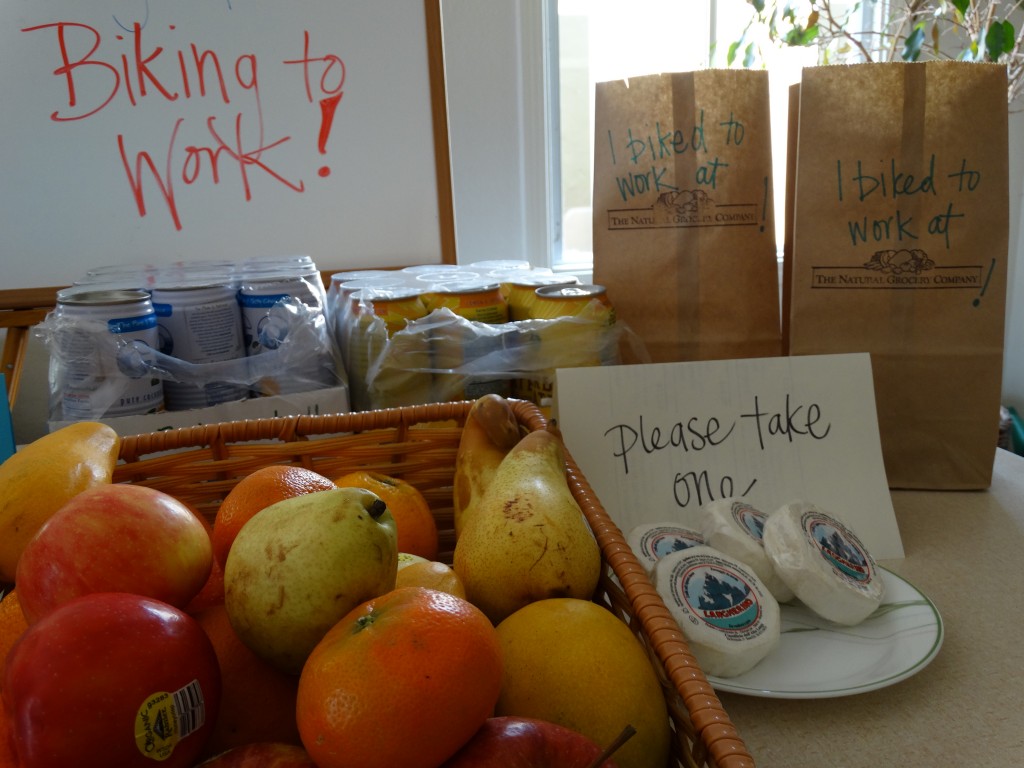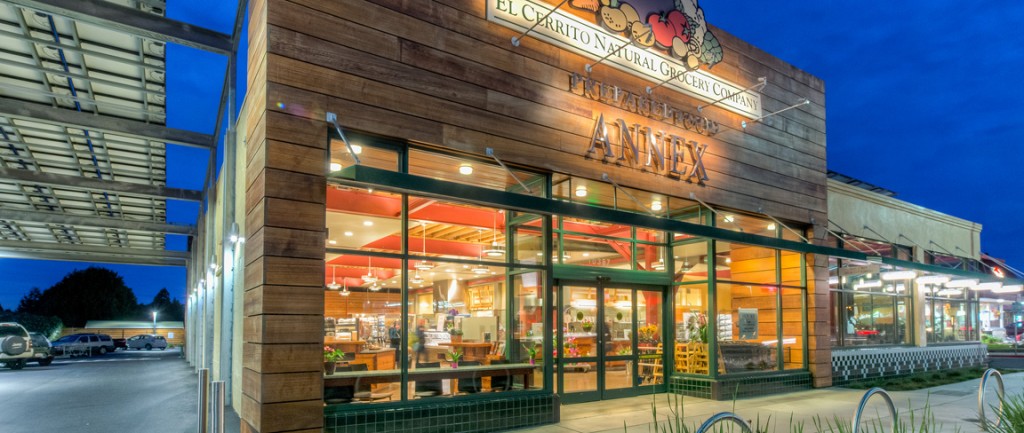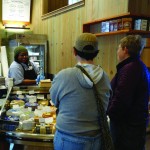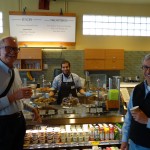Lettuce is local, green beans are close, our all-organic produce nourishes you most. Nah, really shouldn’t try to rhyme in produce notes. Although rhythm is a powerful driver of what is great to eat on any given day. The turning of the Earth; the cycling of water from sea to sky to rain and snow to river flow; the birth of new plants and animals, their death and decay (composting, even) to nourish the next generations of plants and animals; the chill (we hope) of Winter, the green of Spring, the langourous heat of Summer, the collected weight of the year’s sunshine and rain hanging from trees and vines for Autumn harvest to store for our Winter sustenance. These rhythms, observed and understood by our forbearers, provide the pulse of our nourishment, the daily movement through the seasons of our food supply and the seasons of our lives. And now we’ve passed Memorial Day, the unofficial beginning of Summer.
Now, today, while I’m writing this, we have some delightful, if surprising, early stone fruit.
 First pick Bing Cherries out of the Central Valley and the Sierra Foothills are disconcertingly sweet. I am accustomed to the first pick being only adequate, with flavor and sugar developing as the season progresses. But the two growers providing us Bings are shipping delicious fruit. Another bit of surprise, Frog Hollow Farms is not one of those shippers of Bing Cherries. For the second consecutive year, chilling hours were insufficient to prepare the trees to set a good crop. Frog Hollow offered only Rainier Cherries this year. But one of the Bing’s pollinizers (cross-pollination companion variety), the yellow and red Rainier, produced nicely.
First pick Bing Cherries out of the Central Valley and the Sierra Foothills are disconcertingly sweet. I am accustomed to the first pick being only adequate, with flavor and sugar developing as the season progresses. But the two growers providing us Bings are shipping delicious fruit. Another bit of surprise, Frog Hollow Farms is not one of those shippers of Bing Cherries. For the second consecutive year, chilling hours were insufficient to prepare the trees to set a good crop. Frog Hollow offered only Rainier Cherries this year. But one of the Bing’s pollinizers (cross-pollination companion variety), the yellow and red Rainier, produced nicely.
Lots of nutrition to go with the deliciousness here. Sweet cherries are rich in anthocyanins and Vitamin A, provide a nice supply of dietary fiber, contain a broad spectrum of trace minerals, a nice little punch of potassium, B vitamins, and a nice little pop of melatonin for sweet sleep (though, admittedly, tart cherries have more).
But, you may ask, why so expensive? According to the Washington State University College of Agricultural, Human and Natural Resource Sciences hand-labor accounts for roughly 60% of the production cost of fresh cherries. So realize that if the cherries are cheap, the workers’ labor was cheap.
Last bit on cherries for now. Later in the summer (official summer) Washington cherries will be abundant. Projections are for a strong crop from Wenatchee and Chelan and Yakima, even from Prosser (home of the original Rainier tree). But if you want California fruit, local fruit from places you know like Gilroy and Sequoia Valley and Linden, get on them now. Real good today.
 When you talk about the breadth of varieties of stone fruit, you can’t help but talk about Modesto. In all the years I knew old college pal Eric the Animal (Modesto born and raised), other than beef I never saw him eat anything but fruit pie. Many of the most flavorful, productive and, dare I say it, interesting varieties available are the product of the tree fruit breeding program of a Modesto gentleman named Floyd Zaiger and his family. Like all good growers and breeders, the Zaigers are mighty hard workers. Each year they plant literally tens of thousands of seedlings in their quest for great varieties.
When you talk about the breadth of varieties of stone fruit, you can’t help but talk about Modesto. In all the years I knew old college pal Eric the Animal (Modesto born and raised), other than beef I never saw him eat anything but fruit pie. Many of the most flavorful, productive and, dare I say it, interesting varieties available are the product of the tree fruit breeding program of a Modesto gentleman named Floyd Zaiger and his family. Like all good growers and breeders, the Zaigers are mighty hard workers. Each year they plant literally tens of thousands of seedlings in their quest for great varieties.
If you grow peaches, nectarines, apricots, plums, cherries and the like, you are looking for numerous qualities in fruit trees. Of course you want trees that will be healthy over the course of their lives. You want them to produce especially delicious fruit. But you’re not just growing fruit for fun or artistic expression. You’re trying to make a living. So you don’t want just one terrific variety to pick on July 2nd and take the rest of the summer off. You’d like an orchard full of varieties you can pick in succession, giving you fruit to sell all summer long. Our first really good yellow nectarine variety (and they’re almost gone, but I’ll tell you about them anyway, plenty more fine varieties to come) is the ZeeFire. If you see that “Zee” in the name on the display sign, that is certainly a variety bred by the Zaigers. The ZeeFire can be harvested in the Central Valley as early as mid-May. The texture is nicely dense, the flavor concentrated, the juice almost syrupy. So you don’t have to wait until July and August for good nectarines. The first good white nectarine variety is also a Zaiger-bred selection, Polar Light. Same qualities, dense, concentrated, syrupy, but white nectarines have very little acid, so no tartness, and a floral character not generally found in yellow nectarines. Good early nectarines, surprising, yes?
More surprises? Next edition I’ll tell you a little more about “interspecifics”, but for now I’ll just say Aprium, a tasty apricot x plum cross, is not weird science, just good old-fashioned, pollen-brushed-on-stigma, grow the little tree, harvest a fruit, grow the seed, repeat a thousand times plant breeding.
Ok, blueberries fast. We are in the flush time in California blueberry season. Growers have enough fruit that even little independent grocers with all-organic produce departments like us have access to big fat blueberries in big fat 18 oz packages. The eating quality is high, the nutrition places blues in the category of “Superfoods”, and at least three people I know (ok, I’m one of the three) are eating about a pint of them a day.
Pancake special. The mangoes sliced onto this morning’s pancakes (and yes, of course all the ingredients were organic) were Hadens. I picked ripe fruit off the display in El Cerrito yesterday, paid 99 cents apiece. Very flavorful, very reasonably priced. The raspberries were from JW Farms in Watsonville. Delivered to us directly by the grower, they cost me $2.99. Sweet, aromatic, nicely tender. Did we bother with syrup on the cakes? Nope.
And what was the side dish on Pancake Saturday? Butter lettuce salad with fig vinaigrette. Salad is great breakfast fare if you just open your mind to it. Most of our lettuces at the Natural Grocery are coming from no further away than Salinas. We’re getting red and green butters from, amongst other, Blue Heron in Coralitos, Phil Foster Ranches in Hollister, J.E. Perry Farms in Fremont. Butter lettuces have succulent, tender leaves and sweet flavor. Excellent lettuces for breakfast. Really. They’ll be on special for the week of June 1st, $1.69 or $1.49, we’re not sure yet. And all the local lettuce growers in places with decent water supply are coming on, so probably more lettuces at good values to come.
The figs on the salad? Ok, very expensive. The Brown Turkey figs come from Coachella, CA, 500 miles to the Southeast. Our fig season begins a month or so from now. In Coachella today, they’re picking fat, rich, sweet, glorious figs. Very pricey per pound, so I bought only two figs. One was sliced onto last night’s salad (which served 6 people), the other onto this morning’s salad (for 3). Such rich fruit that you can get a great deal of pleasure buying just one.
You probably noticed that we had a shot of great sweet corn for a couple of weeks. That field is done now. Don’t know when the next grower will show up with corn. Corn is rather water-intensive, so it might be in sporadic supply this summer (we are in a capital D Drought, after all). If you like corn (and require it to be organic to be willing to eat it, as I certainly do, gracious, conventional corn is pretty much a nightmare), the next time you see it on display do not waste the opportunity.
Regarding the green beans – availability is on the rise and the quality has been excellent. We’ve been getting beans mostly out of Fresno and Orange County and the price has been a sane and reasonable $2.99/lb. Very soon there will be fine green beans coming out of Santa Barbara and out of Brentwood. When I do the cooking, they get steamed for just 90 seconds. So last night our little one says “I don’t like this stuff on them. Why do put that on?” as she’s wiping the lemon-shallot dressing off a green bean with her cloth napkin. Admittedly the beans needed no adornment, they were awfully good. We’ll have to work on the napkin thing, though.
Feed your families, feed your friends, nourish yourself, and for the generations who will till the soil we leave them, make it all organic.
Jay Moritz
















